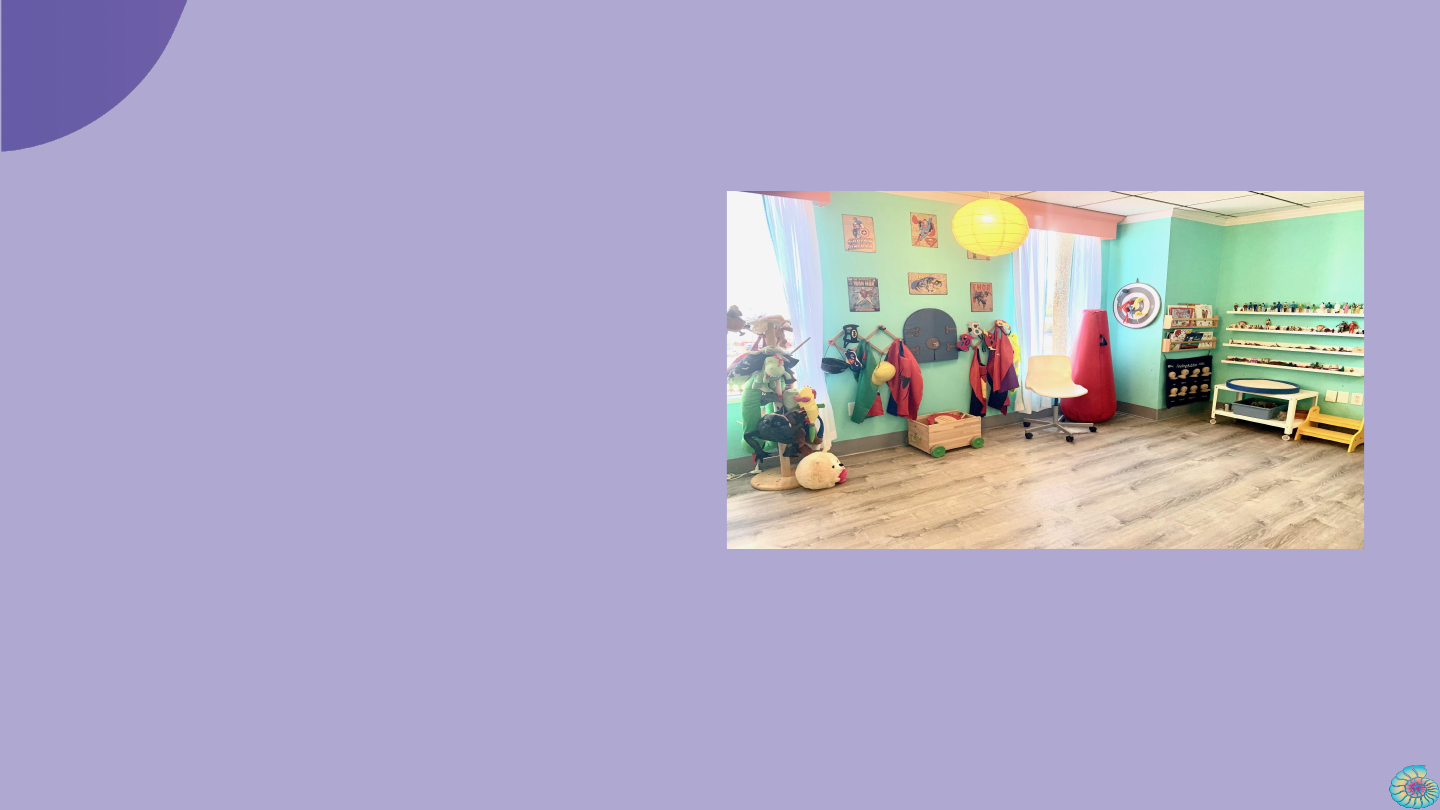
Introduction to
PRINCIPLES OF
PLAY THERAPY
Presented by:
Erica Sartwell, LPC, RPT-S
Halyn Archer, LPC

Introductions
01
Definition of Play Therapy
02
History of Play Therapy
03
04
05
Play Therapy Room
07
Varieties of Play Therapy
Play Therapy Techniques
Characteristics/Role of
Play Therapist
08
09
11
Play Therapy Skills
Legal/Ethics
10
Stages in Child
Development
06
Play Therapy Theories

Introductions
01

Erica has over 20 years experience working in the field of mental
health. Erica specializes in Play Therapy, EMDR, and DBT and
DBT-C. In her free time, Erica enjoys spending time with her 3
teenagers, travelling with her husband, 3 Huskies and 2 cats.
Halyn is a Licensed Professional Counselor in Virginia. Halyn is
trained in Animal Assisted Play Therapy as well as EMDR.
Halyn enjoys spending time with her fiance and therapy dog
Zeke.

What is Play Therapy?
02

Why Play Therapy?
● Play is the child’s natural medium of
self-expression (Axline, 1974).
● “Play is the highest expression of human
development in childhood, for it alone is
the free expression of what is in a child’s
soul.” - Friedrich Froebel
● Play therapy may be directive in
form-that is, the therapist may assume
responsibility for guidance and
interpretation, or it may be
non-directive; the therapist may leave
the responsibility and direction to the
child (Axline, 1974).
“Play Therapy is an ideal
therapeutic approach to help
children and teens process through
difficult life circumstances,
re-pattern maladaptive behaviors,
engage in healthy relationships
with self and others, as well as
regulate emotions.”
-Jackie Flynn

Definition of Play Therapy
● Play therapy is a psychotherapeutic approach
primarily used to help children ages 3 to 12 explore
their lives and freely express repressed thoughts and
emotions through play. Therapeutic play normally
takes place in a safe, comfortable playroom, where
very few rules or limits are imposed on the child,
encouraging free expression and allowing the
therapist to observe the child’s choices, decisions,
and play style. The goal is to help children learn to
express themselves in healthier ways, become more
respectful and empathetic, and discover new and
more positive ways to solve problems.
(psychologytoday.com)
● The Systematic use of theoretical model to establish
an interpersonal process where in trained play
therapists use the therapeutic powers of play to help
clients prevent or resolve psychosocial difficulties
and achieve optimal growth and development.
(www.a4pt.org)

Benefits of Play
● Develop problem-solving skills
● Develop coping skills
● Support emotional healing and growth
● Promote decision making
● Promote accepting responsibility
● Reduce stress
● Build self-esteem
● Boosts energy
● Develop pleasant memories
● Develop social skills
● FUN!!

History of
Play Therapy
03

History of Play Therapy
“You can discover more
about a human being in
an hour of play than a
year of conversation.”
Plato (429 - 347 B.C.)

The History of Play Therapy (con’t.)
● 1782-1852 Friedrich Froebel- German Philosopher who coined the term Kindergarten. Created Froebel
gifts to demonstrate that children learn through play.
● 1856-1959 Sigmund Freud - In the case of “Little Hans”, Freud recommended play.
● 1871-1924 Hermine von Hug Hellmuth - became the first to formally treat children through talk and play
1890-1973 Margaret Lowenfeld- Left pediatrics to begin the psychiatric treatment of children. Lowenfeld
later determined the The World Technique can be used with all ages. Margaret Lowenfeld's approach to child
Psychotherapy - YouTube
● 1882-1960 Melanie Klein- one of the first play therapists, encouraged children to use toys and play
materials
● 1895-1982 Anna Freud - Founded the first psychoanalytic center for children in London in 1953
● 1895-1971 D. W. Winnicott- wrote about the role of play in child development
● 1904-1990 Dora Kalff - Jungian Sandplay Therapist went to study with Margaret Lowenfeld.
https://www.youtube.com/watch?v=aWd40dMH70c
● 1911-1988 Virginia Axline - Based on Carl Rogers Person centered movement - Non-directive Play Therapy
1960-1970 Gary Landreth - Founder of Largest Play Therapy Training Center in the World
1980-1990 International Association for Play Therapy - emphasis on creative techniques and increase in
training programs: Regulation of “Registered Play Therapists”
2000-Present Expansion of APT and increased PR for Play Therapy - emphasis on research and efficacy of
Play Therapy - Regulations specific to supervision implemented in 2009

Characteristics/Role
of Play Therapist
04

Characteristics of a Play Therapist
● Open-minded
● Patient
● Compassionate
● Sense of humor
● Open and honest
● Willingness to use play as
vehicle for communication
● Flexibility and ability to handle
ambiguity
● Sensitive
● Understanding
● Warmth
● Accepting
● Ability to set limits and
maintain personal boundaries
● Ability to respond in a way to
help children feel understood,
valued, accepted, and safe

Professional Role
● Focus on the relationship with the client
○ Acceptance, unconditional positive regard, and empathy
● Knowledge and understanding of the developmental stages
○ Erikson’s Psychosocial
○ Piaget’s Cognitive Development
○ Kohlberg Moral
● Working collaboratively with the Caregivers
○ Psychoeducation
○ Child-Parent Relationship Therapy (CPRT)
○ Parent-Child Interaction Therapy (PCIT)
○ Conscious Discipline
● Competence
○ Supervision, consultation, research, and continuing education

Modalities of
Play Therapy
05

Directive vs. Non-Directive
Play Therapy
Directive Play
Therapy
● The THERAPIST has the
power to make the
decisions about what
happens in the play
therapy room.
Non-Directive Play
Therapy
● The CHILD has the power
to make decisions about
what happens in the play
therapy room.

Directive Play Therapy
● Directive Play Therapy can range
from being well-stocked with
carefully selected toys to being in an
empty room with the only toys
brought in being those that are
needed for the intervention
(Turner-Bumberry, 2018).
● Examples of a more directive
approach may include Theraplay,
Adlerian Play Therapy, Cognitive
Behavioral Play Therapy,
Trauma-Focused Cognitive
Behavioral Play Therapy, Eye
Movement Desensitization and
Reprocessing.

Virginia Axline’s Basic Principles for
Non-Directive Play Therapy
1. The therapist must develop a warm and friendly relationship with the child to
establish rapport as soon as possible.
2. The therapist must accept the child exactly the way they are.
3. The therapist must establish a feeling of permissiveness in the relationship in
order for the child to feel free to express their feeling completely.
4. The therapist must be alert to recognize the feelings that the child is expressing
in order to reflect those feelings back to the child, so that they gain insight into
their behavior.

Virginia Axline’s Basic Principles for
Non-Directive Play Therapy (con’t.)
5. The therapist must sustain deep respect for the child’s ability to solve their own
issues if they are given the opportunity. The child has the responsibility to make
changes.
6. The therapist does not attempt to direct the child’s actions or conversation in any
way. The child leads the way and the therapist follows.
7. The therapist does not attempt to rush therapy along, in which is seen as a
gradual process.
8. The therapist establishes limits and boundaries that are necessary to anchor the
therapy to the world of reality and to make the child responsible for the
relationship.

Integrative Play Therapy
● The blending together of healing
elements from different schools of
play therapy into one combined
approach
● Due to most disorders being
multidetermined, an integrated,
multifaceted course of treatment is
needed (Gerard Kaduson,
Cangelosi, & Schaefer, 2020).

Eliana Gil’s Integrative Play Therapy
● Eliana focuses on therapeutic approaches that are child-sensitive, developmentally
appropriate and maintain sensitivity to gender-differences and gender variances.
● Eliana utilizes Expressive Therapies (sand, play, art, yoga, and drama), Cognitive Behavior
Therapy, Attachment-Based, and Trauma-based Play Therapy.
● Eliana’s Extended Play Based Developmental Assessment (2011), is an integrative model that
utilizes a combination of play-based activities and a backdrop of child development
theory.
○ Session 1-3: Free play activities
○ Session 4: Individual play genogram
○ Session 5: Build a world in the sand
○ Session 6: Color your feelings
○ Session 7: Self portraits
○ Session 8: Kinetic family drawings
○ Session 9-12: Closure

Play Therapy
Approaches &
Theories
06

Theories and Approaches
● Child Centered- Gary Landreth
● Adlerian- Terry Kottman
● Psychoanalytic
● Jungian
Sandplay-www.sandplay.org
● Gestalt- Violet Oaklander
● Cognitive Behavioral
● Prescriptive/Integrative- Eliana
Gil
Kineticvideo.com -
PLAY-THERAPY-FOR-SEVERE-PSYCHOLOGICAL
-TRAUMA-15614 - YouTube
● Eye Movement Desensitization
Processing- www.emdria.org
● Dialectical Behavioral Therapy -
For Children- www.childdbt.com
● Animal Assisted Play Therapy-
Rise Van Fleet

Child Centered Play Therapy (CCPT)
● Focus on the child’s strengths, reflect on their feelings, and
acknowledge the power of the therapeutic relationship.
● Therapist will observe the child and reflect, not evaluate or
question the child’s thoughts or behaviors.
● Client-Centered Play Therapy is when the therapist gives the
child permission to be themselves, providing unconditional
acceptance that averts judgement or evaluation (VanFleet,
Sywulak, & Caparosa Sniscak, 2010).
● This amount of acceptance allows the child discover, explore,
and accept themselves.
● The child will then be able to take full responsibility for their
behavior, attitudes, and emotional growth (VanFleet, Sywulak,
& Caparosa Sniscak, 2010).

Eye Movement Desensitization
Reprocessing
● EMDR’s main focus is on the stimulation of adaptive information processing system of the brain in
order to promote the integration of memories of trauma and adversity that lay at the core of the child’s
current suffering and difficulties (Gomez, 2013).
● The interplay of directive and non-directive play therapy guided EMDR is like an infinity symbol that
balances the interplay of opposites, such as two hemispheres of the brain. By combining the two
dynamic methods of play therapy and EMDR, it offers children ways to process both experientially and
cognitively according to their developmental ability (McGuiness, 2011).

Dialectical Behavioral Therapy -
Children(DBT-C)
● Dialectical Behavioral Therapy for Children (2016), was created by Francheska
Perepletchikova to address treatment needs of children ages 6-11 with severe
emotional dysregulation and corresponding behavioral miscontrol.
● DBT-C contains the theoretical model, principles, and therapeutic strategies of
standard DBT, however the presentation of DBT-C are considerably different to
accommodate for the developmental and cognitive levels of pre-adolescent
children (DBT-C, 2016). .
● DBT-C focuses on decreasing the risk of psychopathology in the future, targeting
the parent-child relationship, and targeting the child’s presenting issues.

“e integrated involvement of
animals in the context of play
therapy, in which appropriately
trained therapists and animals
engage with clients primarily
through systematic playful
interventions, with the goal of
improving clients’ developmental
and psychosocial health, while
simultaneously ensuring the animal’s
well-being and voluntary
engagement. Play and playfulness
are essential ingredients of the
interactions and the relationship”
-Risë VanFleet
Animal Assisted Play Therapy (AAPT)

07
Play Therapy
Techniques

Play Therapy Techniques
● Sandtray
● Expressive arts
● Games
● Bibliotherapy
● Music
● Role-Play

Sandtray
● The miniatures that are used in the
sandtray include a variety of things,
such as buildings, people,
transportation, animals, nature,
symbolic objects, etc.
● https://www.youtube.com/watch?v=DE
XHWdLD1Og
● Client’s choose which miniatures to
incorporate into the sandtray and
arrange them in any way they wish.
Meanwhile, the therapist mainly serves
as the observer (Morin, 2020).

Expressive Arts
● Expressive Art Therapy is a combination
of using psychology and the creative
process to promote emotional growth
and healing.
● Expressive Arts Therapy for children may
include music, movement, drawing,
painting, collaging, and creating.

Games
● Games can be used in non-directive
and directive play therapy.
● There are various play therapy
games that are created to target
specific topics, such as emotion
regulation, communication, emotion
identification, self-regulation, etc.
● A few examples are:
○ Totika
○ The Color Monster
○ Emotions Quartets
○ Bright Spots
○ Mad Dragon

Bibliotherapy
● Bibliotherapy may be used to help
children overcome problems by having
them read stories or the therapist
reading the story, about characters
who have successfully resolved an
issuer similar to their own (Davies,
n.d.).
● The main goals of bibliotherapy are to
assist children with:
○ Identify and validate feelings
○ Encourage discussion
○ Foster self-awareness
○ Learn coping skills

Music
● Musical instruments are often used
during non-directive play therapy.
● When the child chooses a musical
instrument the role of the therapist is to
track the child’s behavior and reflect
feeling.

Role-Play
● Role-play gives the child an
opportunity to project their feelings
onto a puppet and interact with
other puppets of their choice.
● It is essential to have a variety of real
life characters and fantasy
characters for puppets and
costumes.
● Puppets and costumes promote
imaginative play

08
Play Therapy
Skills

Basic Play Therapy Skills
● Tracking
● Reflecting feelings
● Returning responsibility
● Limit/Boundary setting
● Metaphor & Storytelling

Tracking
● Tracking the child’s behavior is the most basic
of responses of the therapist in play therapy.
● The therapist tracks the child’s behavior by
verbally responding to the child’s behavior
simply by stating what is seen or observed
(Ray, 2004).
● Tracking let’s the child know that the
therapist is interested and accepting of their
behavior.
● By tracking the child’s behavior it promotes
self-confidence, assigning meaning to their
thoughts, actions, and feelings, learn to
resolve inner conflicts, and organize
expression.

Reflect Feeling
● The therapist reflects the child’s
feelings that they are expressing
during the play therapy session
● Reflecting feeling promotes
acceptance, validation, emotion
identification and expansion of
vocabulary of the child.
● The therapists must reflect the surface
and underlying feelings the child is
demonstrating.

Returning Responsibility
● The therapist may return responsibility to
the child for executing behaviors and
making decisions in efforts to promote
autonomy.
● By returning responsibility to the child it
empowers them and encourages
independence, builds confidence and
facilitates decision-making.
● Examples:
○ You can choose..
○ You can decide…

Limit/Boundary Setting
● Limits must be reasonable, minimal,
necessary, consistent, firm, kind, and
rational.
● Basic limits and boundaries:
○ Duration of play therapy session
○ Harm to self, therapist, & toys
● Garry Landreth’s 3 steps for limit
setting:
● Acknowledge feelings
● Communicate the limit
● Target and/or brainstorm
and alternative
“The therapist establishes only those limitations that
are necessary to anchor therapy to the world of reality
and to make the child aware of his responsibility in the
relationship.”
-Virginia Axeline

Inside the Play
Therapy Room
09

The Play Therapy Room
● Inviting and safe space
● Organized - meaning everything
has its own place
● Sets tone for the play therapy
session
● Must be cleaned up between
sessions to ensure the
environment is predictable for
each client.

Garry Landreth’s
Purposeful Toy Selection
● Variety in choice of expression
● Durable and not complex
● Allow reality testing limits
● Allow development of positive
self-image as well as self-control
● The Three main toy categories:
○ Real life
○ Aggressive- Release
○ Creative Expression
“Toys and materials should
be selected, not collected."
-Garry Landreth

Real Life Toys
● Dolls-
● Dollhouse
● Puppets
● Cars
● Boats
● Airplanes
● Cash register
● Kitchenette with food, plates, drinks, etc.

Aggressive-Release Toys
● Nerf guns
● Toy soldiers
● Bobo (punching bag)
● Bench & hammer (tool bench)
● Balls
● Foam bat
● Things that can be physically broken down
and destroyed:
○ popsicle sticks
○ egg cartons
○ bubble wrap

Creative Expression Toys
● Paints & paint brushes
● Crayons, markers, & colored pencils
● Construction Paper
● Children scissors
● Glue
● Ingredients to create slime (gentle/soft
detergent & glue)
● Glitter
● Pipe cleaners
● Play-doh

More on Purpose of Toys
Nurturing Toys- Children often use these types of toys when exploring feelings about family relationships and will often re-create
situations that occur outside of the play therapy room. (Kottman, 2016)
Scary Toys- Children often use these types of toys when dealing with their feelings of fear whether real or imagined. (Kottman, 2016)
Aggressive Toys- When dealing with feelings of anger and fear or to explore issues of power and control, children may use aggressive
toys (Kottman, 2016).
Expressive Toys- Children are able to illustrate how they see themselves, others and the world through expressive arts (Kottman, 2016)
Pretend Fantasy Toys- Children use pretend play to explore relationships, roles and act out situations (Kottman, 2016)

Stages in Child
Development
10

Stages in Child Development
Ages Freud
Personality
Erikson
Psychosocial
Piaget
Cognitive
Kohlberg
Moral
0-1 Oral Tust vs. Mistrust Sensory - motor Pre- conventional
1-2 Anal Autonomy vs.
Shame & Doubt
Pre-conceptual
Thought
---------------
3-4 Phallic Initiative vs. Guilt Intuitive Thought ---------------
5-12 Latency Industry vs.
Inferiority
Concrete-
operational
Thought
Limited
Conventional
Over 12 Genital Identity vs. Role
Confusion
Abstract Thought Conventional to
Post - conventional

Freud Psychosexual Development
● Freud also believed that all tension was due to the build-up of libido (sexual energy)
and that all pleasure came from its discharge.(McLeod, 2019).
● Each of the psychosexual stages is associated with a particular conflict that must
be resolved before the individual can successfully advance to the next stage
(McLeod, 2019).
● The psychosexual stages of development:
○ Oral (Birth-1 year): Children get pleasure from oral activities, such sucking,
swallowing, chewing.
○ Anal (1-3 years): Children begin potty training.
○ Phallic (3-6 years): Boys are more attached to their mother and girls are more
attached to their father.
○ Latent (6-puberty): Children spend more time with same sex peers.
○ Genital (puberty-adult): Maturation and sexual orientation.

Erikson Psychosocial Development
● Each stage in Erikson's theory builds on the preceding stages and paves the
way for following periods of development. In each stage, Erikson believed
people experience a conflict that serves as a turning point in development.
(Cherry, 2020).
● 8 psychosocial stages of development:
○ Stage 1 (Infancy): Trust vs. Mistrust
○ Stage 2 (Early Childhood): Autonomy vs. Shame & Doubt
○ Stage 3 (Preschool): Initiative vs. Guilt
○ Stage 4 (School Age): Industry vs. Inferiority
○ Stage 5 (Adolescence): Identity vs. Confusion
○ Stage 6 (Young Adulthood): Intimacy vs. Isolation
○ Stage 7 (Middle Adulthood): Generativity vs. Stagnation
○ Stage 8 (Maturity): Integrity vs. Despair

Piaget Cognitive Development
● Piaget's theory of cognitive development
suggests that children move through four
different stages of mental development.
His theory focuses on understanding how
children acquire knowledge and
understanding the nature of their
intelligence (Cherry, 2020).
● The 4 stages of cognitive development:
○ Stage 1 (Birth-2 years): Sensorimotor
○ Stage 2 (2-7 years): Preoperational
○ Stage 3 (7-11 years): Concrete
operational
○ Stage 4 (11 and up): Formal
operational

Kohlberg Moral Development
(McLeod, 2013)
● Kohlberg agreed with Piaget's theory of moral development in principle but wanted
to develop his ideas further.
● Level 1: Pre-Conventional Morality
○ Stage 1: Obedience & Punishment Orientation
○ Stage 2: Individualism & Exchange
● Level 2: Conventional Morality
○ Stage 3: Good Interpersonal Relationships
○ Stage 4: Maintaining the Social Order
● Level 3: Post-Conventional Morality
○ Stage 5: Social Contract & Individual Rights
○ Stage 6: Universal Principles

11
Legal & Ethical
Implications

Play therapy Legal and Ethical
Implications
● Duty to Warn
● Informed Consent/Court
Orders
● Client Competency
● Do No Harm
● Dual relationships
● Court Appearance/GALs

References
Axline, V. (1974). Play Therapy. The Random House Publishing Group.
Cherry, K. (2020). Erik Erikson’s stages of psychosocial development. Very Well Mind. Retrieved from
https://www.verywellmind.com/erik-eriksons-stages-of-psychosocial-development-2795740
Cherry, K. (2020). The four stages of cognitive development.. Very Well Mind. Retrieved from https://www.verywellmind.com/piagets-stages-of-cognitive-development-2795457
Cherry, K. (2019). What is psychoanalytic Therapy? Very Well Mind. Retrieved from https://www.verywellmind.com/what-is-psychoanalytic-therapy-2795467
Davies, L. (n.d.). Using bibliotherapy with children. Kelly Bear. Retrieved from http://www.kellybear.com/TeacherArticles/TeacherTip34.html
Dialectical Behavioral Therapy for Children (2016). Behavioral Tech. Retrieved from https://behavioraltech.org/dbt-for-children/
Drewes, A. & Cavett, A. (2019) Cognitive behavioral play therapy. Play Therapy. Retrieved from
https://cdn.ymaws.com/www.a4pt.org/resource/resmgr/publications/pt_theories/CognitiveBehavioral__Sept201.pdf
Erikson, E.H. (1963) Chapter 6. In Childhood and Society. New York: Norton.

References (con’t.)
Expressive Art Therapy (n.d.) Psychology Today. Retrieved from https://www.psychologytoday.com/us/therapy-types/expressive-arts-therapy
Flynn, J. (2017, November 9). Play Therapy Community. Retrieved from
http://playtherapycommunity.com/index.php/2017/11/09/63-adlerian-play-therapy-with-dalena-dillman-taylor-phd-lpc-rpt/
Frey, D. E. (1993). Learning by metaphor. In C. E. Schaefer (Ed.), The therapeutic powers of play (pp. 223-240). Northvale, NJ: Jason Aronson.
Gerard Kaduson, H. G., Cangelosi, D., & C. E. (2020). Prescriptive play therapy: Tailoring interventions for specific childhood problems. A Division of Guilford Publications.
Gil, E. (2011). Extended play-based developmental assessment. Self Esteem Shop.
Gomez, A. (2013). EMDR Therapy and adjunct approaches with children. Springer Publishing Company.
Green, E. J. (2005). Jungian play therapy: Bridging the theoretical to the practical. In G. R. Walz & R. K. Yep (Eds.), VISTAS: Compelling perspectives on counseling, 2005 (pp. 75-78). Alexandria, VA:
American Counseling Association
Guinness, V. A. (2011). Integrating play therapy and EMDR with children. In A. A. Drewes, S. C. Bratton, and C. E.

References (con’t.)
Hicks, B. (2017). Phases of treatment in play therapy. Brenda Hicks Parenting Coach. Retrieved from
https://www.brennahicks.com/2017/02/phases-treatment-play-therapy/
Hinman, C. (2003). Multicultural considerations in delivery of play therapy services. International Journal of Play Therapy. 12(2):107-122, doi: 10.1037/h0088881
https://www.a4pt.org/
https://www.psychologytoday.com
Knell, S. M. (2011). Cognitive-behavioral play therapy. In C. E. Schaefer (Ed.), Foundations of play therapy (2nd ed., pp. 313-328). New York, NY: John Wiley & Sons
Kottman, T. & Meany-Walen, K. (2016). Partners in Play (3rd.ed. pp 6-12). American Counseling Association.
Landreth, G. L. (2012). Play therapy: The art of the relationship. (3rd ed.). New York: Brunner-Routledge.
McLeod, S. (2019). Freud’s pscyhosexual stages of development. Simply Psychology. Retrieved from https://www.simplypsychology.org/psychosexual.html
Mcleod, S. (2013). Kohlberg’s stages of moral development. Simply Psychology. Retrieved from https://www.simplypsychology.org/kohlberg.html
Morin, A. (2020). What is sandtray therapy? Very Well Mind. Retrieved from https://www.verywellmind.com/what-is-sand-tray-therapy-4589493

O’Connor, K.J, (2015). Ecosystemic Play Therapy. Handbook of Play Therapy. Retrieved from https://doi.org/10.1002/9781119140467.ch9
Pernicano, P. (2015). Metaphors and stories in play therapy. Handbook of Play Therapy. Retrieved from https://doi.org/10.1002/9781119140467.ch12
PsychotherapyNet. [PsychotherapyNet]. (2009, July 1). Adlerian Play Therapy Video. {Video}. https://www.youtube.com/watch?v=TiF-DTS6aF0
PsychotherapyNet. [PsychotherapyNet]. (2013, July 26). Reality Therapy with Children Video. [Video]. https://www.youtube.com/watch?v=JeQkk-VXnvk
PsychotherapyNet. [PsychotherapyNet]. (2009, May 6). Violet Oklander Gestlat Child Therapy Video. [Video]. https://www.youtube.com/watch?v=Okkk1XbF6zE&t=11s
Ray, D. (2004). Supervision of play therapy. Journal of Professional Counseling Practice, Theory, & Research. Retrieved from
https://cdn.ymaws.com/www.a4pt.org/resource/resmgr/Resource_Center/Supervision_of_basic_and_adv.pdf
Routledgetherapy. [Routledgetherapy]. (2012, May 16). Child-Centered Play Therapy DVD Preview. [Video]. https://www.youtube.com/watch?v=JIMWOOlR_9g&t=46s
Schaefer (Eds.), Integrative play therapy (pp. 195-206). Hoboken, NJ: John Wiley & Sons Inc. doi:10.1002/9781118094792.ch11
Sprouts [Sprouts]. (2018, August 1). Piaget’s theory of cognitive development. [Video]. https://www.youtube.com/watch?v=IhcgYgx7aAA
References (con’t.)

References (con’t.)
Turner-Bumberry, T. (2018). 2, 4, 6, 8 This is how we regulate. PESI Publishing & Media.
VanFleet, R., Sywulak, A. E., & Caparosa Sniscak,. C. (2010). History, theory, principles, and variations of child-centered play therapy. Child-Centered Play Therapy. Retrieved from
https://www.guilford.com/excerpts/vanfleet.pdf?t


